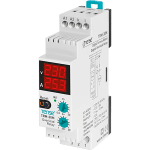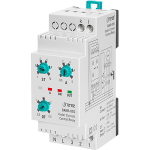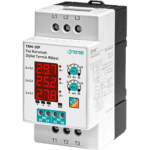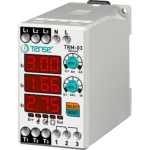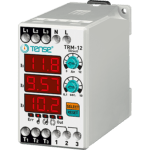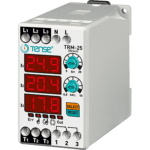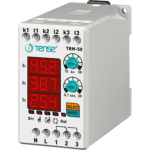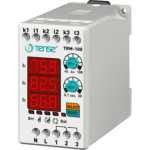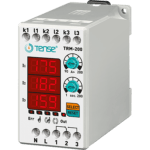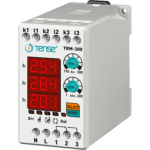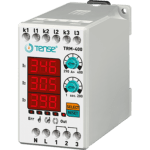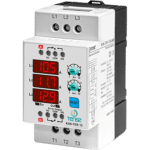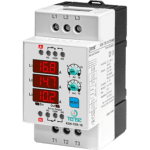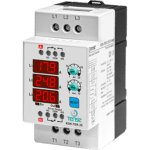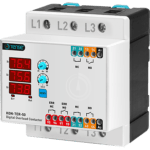Digital Contactor and Overload Relays PRODUCTS
PRODUCT TYPE
WHAT IS OVERLOAD RELAY?
Digital overload relay monitors the current values and these relays are used for protecting the engines from high currents. These are mostly used in devices that operate at sensitive current levels. The relays continuously monitor the input current to the device and activate if the load is higher than the set value. The contact is closed and prevents any damage or failure on the equipment.
When we consider the operating principle, we can see that the digital overload relays do not provide protection on their own. You need to use equipment to cut the circuit in case of a overload relay alarm. This equipment is either fuse or contactor.
WHAT IS A CONTACTOR AND WHAT DOES IT DO?
The contactor is a relay-like part as its working principle. It is useful for switching electric motors. Although it is also referred to as a contactor relay; can be used at much higher currents than relays. It provides contact closure with the load on the coil in its structure.
What is Overload Contactor?
”Overload contactor” is an abbreviation used in the electronics community for devices that include both contactor and overload relay. We also often see it used as a contactor and overload.
The cause of manufacturing and usage of this kind of devices is when these devices combine in just one product, they save up from place and expenses. It does not vary in function and way of usage.
How should choosing a digital overload relay be done?
Because of this equipment’s preventative role, the process of choosing a overload relay should be done carefully. Taking operating technical values into consideration is of great importance when doing the choice. Overload value, asymmetry level, error delay time are the first things you should look into. It is a huge advantage if these values are adjustable.
If the device is in your ‘’technically enough’’ list, you can look through non-vital but important features such as screen features, ease of use of adjustment controls, having different operating modes, and current transformer being internal or external.
How should choosing a contactor should be done?
As it is on all protective electronic system devices, the first thing you should focus on when choosing a contactor should be that the device you will choose is suited for the place that you will use it on. In addition to that; even if contactors are digital since they are performing a mechanical task, material quality is important. You should definitely check the mechanical and electrical life expectancy of the contactor that you will choose.
After technical matters, you should go through details like display screens, cable diameter, installation type, and connection type.
Tense Digital Contactor and Overload Relay Products Selection Chart
Tense Electronics product family includes a built-in current transformer, external current transformer overload relays and digital contactor only models.
You can click on the product to learn more about the things you need to consider and information that will help you to choose these elements.
| Product Code | High Current | Adjustable Overload Value | Delay | Error Delay Time Adjustable | Internal Current Transformers | External Current Transformers | Over Voltage Protection | Under Voltage Protection | Asymmetry Protection | Internal Contactor |
|---|---|---|---|---|---|---|---|---|---|---|
| TRM-30F | 0,5A – 30A | 0sec – 20sec | 400V (Fixed) | 265V (Fixed) | 50% | |||||
| TRM-03 | 0,1A – 3A | 0,1sec – 10sec | 50% | |||||||
| TRM-12 | 3A – 12A | 0,1sec – 10sec | 50% | |||||||
| TRM-25 | 0,1A – 25A | 0,1sec – 20sec | 50% | |||||||
| TRM-50 | 15A – 50A | 0,1sec – 20sec | 50% | |||||||
| TRM-100 | 40A – 100A | 0,1sec – 20sec | 50% | |||||||
| TRM-200 | 90A – 200A | 1sec – 200sec | 50% | |||||||
| TRM-300 | 190A – 300A | 1sec – 200sec | 50% | |||||||
| TRM-400 | 290A – 400A | 1sec – 200sec | 50% |
Digital Contactor and Overload Relays Comparison Chart
| Product Code | High Current | Adjustable Overload Value | Asymmetry Protection | Delay | Error Delay Time Adjustable | Internal Current Transformers | Internal Contactor | Shows Number of Using Contacts | Shows Total Working Hours |
|---|---|---|---|---|---|---|---|---|---|
| KON-TER-12 | 1A – 12A | 50% (Fixed) | 1sec – 10sec | ||||||
| KON-TER-18 | 1A – 18A | 50% (Fixed) | 1sec – 10sec | ||||||
| KON-TER-25 | 1A – 25A | 50% (Fixed) | 1sec – 10sec | ||||||
| KON-TER-50 | 25A – 50A | 50% (Fixed) | 1sec – 20sec |

